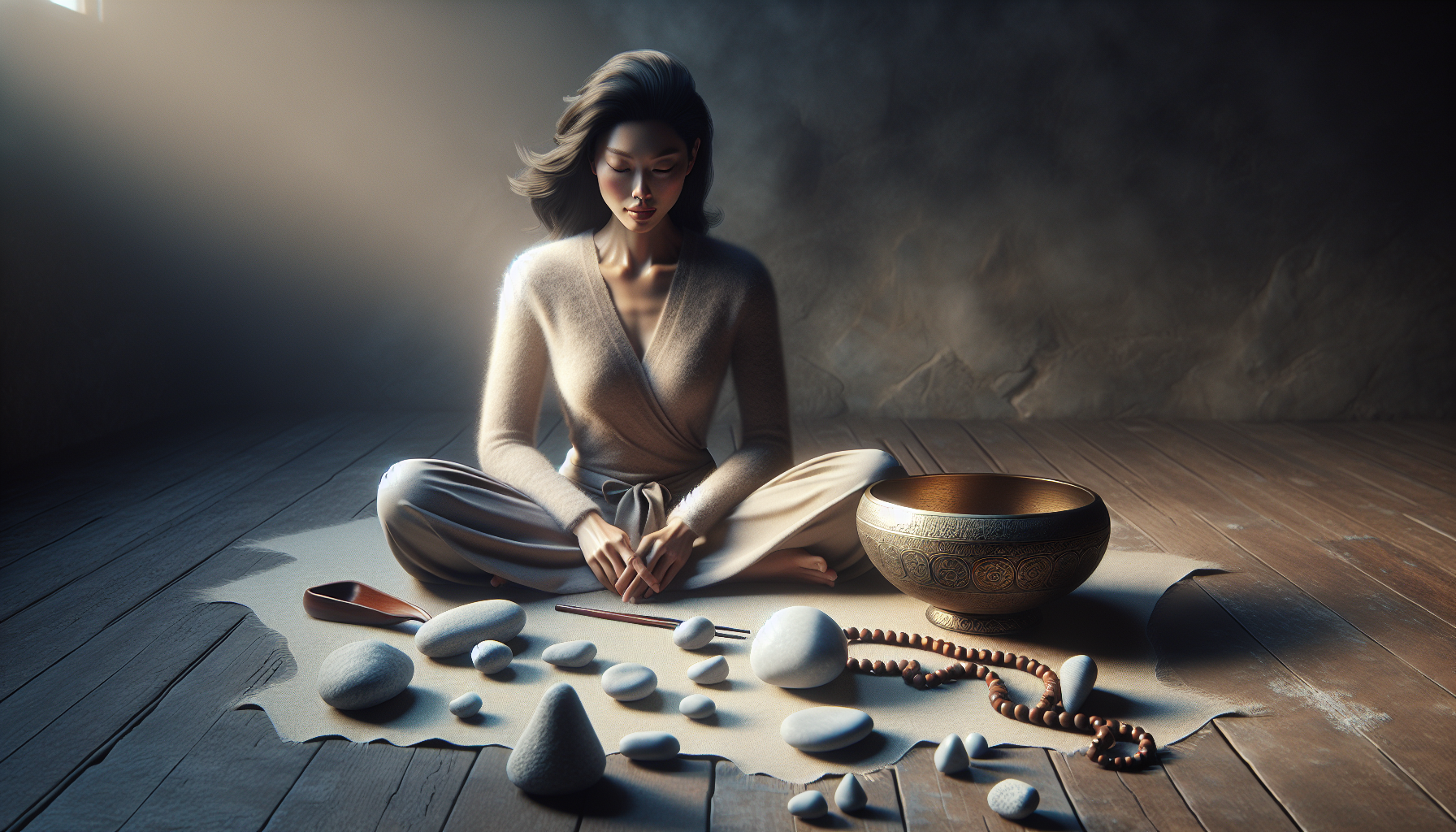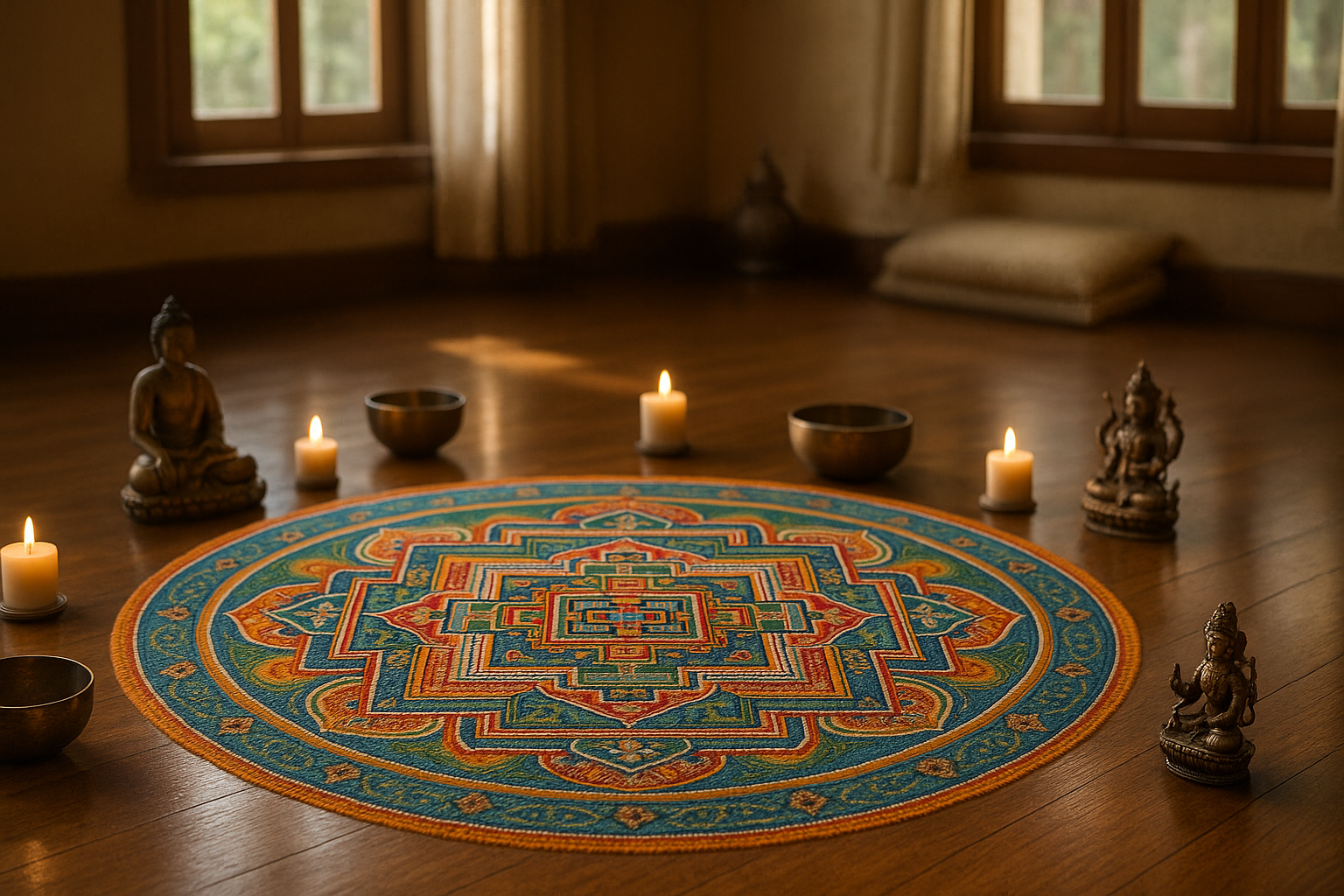In a world that moves at an ever-accelerating pace, finding moments of peace and clarity can feel like trying to catch a fleeting shadow. Our days are often filled with a cacophony of notifications, endless to-do lists, and the persistent hum of modern life’s demands. Amidst this chaos, the ancient practice of mindfulness offers a sanctuary—a return to stillness, presence, and inner peace. But for many, the journey to mindfulness can seem daunting. How do we quiet our racing thoughts? How do we reconnect with ourselves when we feel so disconnected? This is where the power of tactile meditation tools comes into play, offering a tangible pathway to a deeper connection with mindfulness and relaxation.
Tactile meditation tools, often overlooked in the broader conversation about mindfulness, provide a unique and engaging way to anchor ourselves in the present moment. These tools, which range from mala beads to worry stones, offer a physical anchor that can help guide the mind away from distraction and towards a state of calm and focus. Unlike more abstract forms of meditation that rely solely on mental discipline, tactile tools engage our sense of touch, creating a multi-sensory experience that can enhance our meditative practice. This sensory engagement not only aids in concentration but also adds a layer of richness to the experience, making mindfulness more accessible and enjoyable.
One of the remarkable benefits of tactile meditation tools is their ability to ground us in the here and now. In a world where we are constantly urged to think about the next thing—the next meeting, the next email, the next goal—these tools provide a gentle reminder to pause and be present. When we hold a mala bead or run our fingers over a smooth worry stone, we are invited to slow down, breathe deeply, and connect with the simplicity of the moment. This grounding effect can be particularly beneficial for those who struggle with anxiety or stress, as it provides a physical touchpoint that can help soothe and center the mind.
Throughout this article, we will explore the diverse array of tactile meditation tools available and delve into how each can be used to enhance mindfulness and relaxation. We will discuss traditional tools like mala beads, which have been used for centuries in spiritual practices across the globe, as well as modern innovations that cater to the contemporary seeker. Additionally, we will examine the science behind why tactile engagement is so effective in enhancing meditation, drawing on research from psychology and neuroscience to illuminate the profound connection between touch and mental well-being.
The Essence of Tactile Meditation Tools
Meditation has long been revered as a practice for cultivating inner peace, awareness, and mindfulness. In recent years, the practice has evolved, integrating modern tools and techniques that enhance the meditative experience. One such evolution is the use of tactile meditation tools, which are designed to engage the senses, grounding individuals in the present moment. These tools are not only beneficial for seasoned practitioners but also for beginners looking to explore mindfulness in a more tangible way.
Tactile meditation tools provide a multi-sensory experience that can deepen your connection to meditation. By incorporating touch, these tools facilitate a direct link between the mind and body, helping to release stress and promote relaxation. Such tools include mala beads, sand gardens, and meditation stones, each offering unique benefits. They serve as physical anchors, reminding practitioners of their focus and intention during meditation.
The impact of tactile tools on meditation can be profound. As they engage the sense of touch, they can enhance concentration, making it easier to enter a state of mindfulness. For many, this can lead to a deeper, more fulfilling meditation practice. Whether you’re seeking to improve your focus, manage stress, or simply find a moment of peace in your day, tactile meditation tools can be a valuable addition to your routine. 🌿
The Benefits of Using Tactile Meditation Tools
Incorporating tactile tools into your meditation practice can offer numerous advantages. One of the primary benefits is the enhancement of focus. As these tools require physical interaction, they help to anchor your attention, preventing the mind from wandering. This can be particularly beneficial for beginners who may struggle with maintaining focus during meditation.
Additionally, tactile tools can also enhance the sensory experience of meditation. By engaging the sense of touch, these tools help create a richer, more immersive experience. This sensory engagement can make meditation more accessible and enjoyable, encouraging regular practice.
Another significant benefit is the promotion of relaxation. By focusing on the sensation of touch, these tools can help to calm the mind and body, reducing stress and anxiety. This can lead to a greater sense of peace and well-being, making it easier to navigate the challenges of daily life. Check out the table below for a comparison of different tactile meditation tools and their benefits.
| Tool | Benefits | Best For |
|---|---|---|
| Mala Beads | Enhances focus, promotes mindfulness | Beginners and advanced practitioners |
| Sand Gardens | Encourages creativity, reduces stress | Visual and tactile learners |
| Meditation Stones | Grounding, enhances sensory experience | Anyone seeking relaxation |
Exploring Different Types of Tactile Meditation Tools
Delving into the realm of tactile meditation tools, one finds a diverse array of items, each offering distinct benefits. Understanding these tools can help you determine which ones resonate most with your meditation goals and personal preferences. Let’s explore some of the most popular tactile meditation tools and how they can enhance your practice.
Mala beads are among the most traditional tactile tools used in meditation. Originating from Buddhist and Hindu practices, these beads are typically used to count breaths or mantras during meditation. This repetitive action not only aids in maintaining focus but also imbues the practice with a rhythmic, calming quality. Mala beads are particularly beneficial for those looking to deepen their meditation practice through mantra repetition.
Another popular tactile tool is the Zen garden, often referred to as a sand garden. These miniature gardens typically consist of a shallow container filled with sand and various small rocks or sculptures. The act of raking patterns in the sand is a meditative practice in itself, encouraging a state of calm and contemplation. Sand gardens are especially appealing to those who find visual and tactile stimuli helpful in focusing the mind.
Meditation stones, often referred to as worry stones or fidget stones, are small, smooth stones that can be held and rubbed during meditation. These stones serve as grounding tools, anchoring the mind in the present moment through tactile sensation. For those who experience anxiety or restlessness, meditation stones can offer a simple yet effective way to soothe nerves and promote relaxation.
Integrating Tactile Tools into Your Practice
Integrating tactile meditation tools into your daily routine doesn’t have to be complicated. The key is to find tools that resonate with you and your meditation goals. Here are some tips for incorporating these tools into your practice:
- Start small: If you’re new to tactile tools, begin with one item, such as mala beads or a meditation stone, and gradually explore others as you become more comfortable.
- Create a dedicated space: Designate an area in your home for meditation, equipped with your chosen tools. This can help reinforce the habit and make your practice more inviting.
- Be consistent: Consistency is crucial in meditation. Aim to incorporate tactile tools into your practice regularly, whether that’s daily or a few times a week.
For a more comprehensive understanding of how to use tactile tools, watch this YouTube video by [Channel Name] that delves into practical applications of these tools in meditation. 📹
The Science Behind Tactile Meditation Tools
Recent scientific research has shed light on the mechanisms through which tactile meditation tools exert their effects. The sense of touch is a powerful channel for communication between the external world and the internal mind, influencing both physical and emotional states. This connection is evident in the calming effects of tactile tools, which engage the body’s sensory pathways to promote relaxation and mindfulness.
Studies have shown that tactile stimulation can activate the parasympathetic nervous system, the branch of the autonomic nervous system responsible for rest and digestion. This activation counteracts the stress-inducing effects of the sympathetic nervous system, which is responsible for the fight-or-flight response. As a result, engaging with tactile tools can help to lower heart rate, reduce blood pressure, and promote a sense of calm.
Furthermore, tactile stimulation has been found to enhance concentration and focus by providing sensory input that anchors the mind in the present moment. This is particularly beneficial for individuals who find it challenging to quiet their minds during meditation. By engaging the sense of touch, tactile tools offer a tangible focal point, facilitating deeper immersion in the meditative experience.
Research Insights
Recent studies have explored the benefits of tactile meditation tools across various populations. One study examined the effects of using mala beads during meditation and found that participants reported increased focus and reduced anxiety compared to those who meditated without tactile tools. Another study investigated the impact of sand garden raking on stress levels and found a significant reduction in self-reported stress among participants.
These findings suggest that tactile meditation tools can be particularly beneficial for individuals experiencing stress, anxiety, or difficulty concentrating. By providing a physical anchor for the mind, these tools offer a practical and accessible means of enhancing the meditative experience.
If you’re interested in learning more about the science behind tactile meditation tools, check out this insightful video by [Channel Name] on YouTube: Tactile Meditation Tools Explained.
How to Choose the Right Tactile Meditation Tools for You
Selecting the right tactile meditation tools is a personal journey that involves exploring different options and tuning into what resonates with you. With so many tools available, it can be overwhelming to decide which ones to incorporate into your practice. Here are some considerations to keep in mind as you embark on this exploration:
Firstly, consider your meditation goals. Are you looking to enhance focus, reduce stress, or deepen your mindfulness practice? Different tools cater to different needs. For instance, if your primary goal is to improve concentration, mala beads may be a suitable choice. If relaxation is your main focus, you might prefer a meditation stone or sand garden.
Another factor to consider is your personal preferences and sensory inclinations. Do you prefer tactile sensations, visual stimuli, or a combination of both? This can guide you in choosing tools that align with your sensory preferences and enhance your meditation experience.
Additionally, consider the practicality and convenience of the tools. Some tools, like mala beads, are portable and can be easily incorporated into on-the-go meditation practices. Others, like sand gardens, may require a dedicated space at home. Choose tools that fit seamlessly into your lifestyle and meditation routine.
Making an Informed Choice
To assist you in making an informed decision, here are some key points to consider when selecting tactile meditation tools:
- Reflect on your meditation goals and choose tools that align with your intentions.
- Consider your sensory preferences and select tools that resonate with your senses.
- Evaluate the practicality and convenience of the tools in relation to your lifestyle.
- Explore different options and experiment with various tools to discover what works best for you.
By taking these factors into account, you can make an informed choice and create a personalized meditation practice that supports your journey toward mindfulness and relaxation.

Conclusion
**Conclusion: Find Your Zen: Discover the Power of Tactile Meditation Tools for a Deeper Connection to Mindfulness and Relaxation**
In our fast-paced world, the quest for mindfulness and relaxation is more vital than ever. Throughout this article, we’ve delved into the transformative power of tactile meditation tools, exploring how these tools can offer a deeper connection to mindfulness and enhance relaxation. Let’s recapitulate the core insights shared and reinforce the significance of this fascinating topic.
From the outset, we explored the essence of mindfulness—a practice rooted in paying attention to the present moment without judgment. In a society constantly vying for our attention, mindfulness serves as a refuge, a means to reconnect with ourselves and the world around us. Tactile meditation tools, such as mala beads, worry stones, and sensory objects, offer tangible anchors that can ground our practice. By engaging our sense of touch, these tools help to redirect our focus, making it easier to cultivate a state of mindfulness.
One of the key points highlighted was the historical and cultural significance of tactile tools in meditation. Mala beads, for instance, have been used for centuries in spiritual practices across various cultures. Their rhythmic movement through the fingers not only aids concentration but also fosters a deeper sense of connection to our intentions. Similarly, worry stones provide a soothing tactile experience, their smooth surfaces acting as a balm for anxious thoughts.
We also examined the scientific underpinnings of tactile meditation tools. Research indicates that tactile stimulation can activate regions of the brain associated with relaxation and stress reduction. The act of holding and manipulating these tools triggers a sensory response that can lower cortisol levels, the hormone associated with stress, and promote a sense of calmness and well-being.
Furthermore, tactile meditation tools serve as powerful reminders to pause and be present. In an age where digital distractions abound, these physical objects act as symbols of intentionality. Whether placed on a desk, carried in a pocket, or worn as jewelry, they remind us to breathe, refocus, and engage with the world mindfully.
The benefits of tactile meditation tools extend beyond individual well-being. By cultivating mindfulness and relaxation, we can enhance our interactions with others and the environment. The ripple effects of these practices contribute to a more harmonious and empathetic society, where individuals are better equipped to navigate challenges with grace and resilience.
The theme of accessibility was another crucial aspect discussed. Tactile meditation tools offer a simple yet effective entry point for beginners and seasoned practitioners alike. Their portability and ease of use make them versatile companions on the journey to mindfulness, whether at home, in the workplace, or during travel.
As we conclude this exploration, it’s important to reinforce the significance of integrating tactile meditation tools into our daily routines. The journey to mindfulness is deeply personal, and tactile tools provide a customizable and enriching experience. They encourage us to engage with our senses, deepen our practice, and find solace in the tangible.
I invite you, dear reader, to reflect on the insights shared and consider how tactile meditation tools can enhance your mindfulness journey. Experiment with different tools, discover what resonates with you, and allow these objects to become allies in your quest for inner peace. 🌿
Let’s continue this conversation and learn from each other’s experiences. Share your thoughts, insights, and personal stories in the comments below. How have tactile meditation tools impacted your practice? What new insights have you gained about mindfulness and relaxation? Your perspective enriches this dialogue and inspires others on their own paths.
Additionally, I encourage you to share this article with friends, family, or anyone who might benefit from discovering the power of tactile meditation tools. Together, we can foster a community that values mindfulness, relaxation, and genuine connection.
In closing, may your journey towards mindfulness be filled with moments of clarity, tranquility, and joy. Embrace the power of tactile meditation tools as a bridge to deeper awareness and relaxation. Remember, the path to mindfulness is not a destination but a lifelong exploration. As you continue to find your zen, may you inspire others to do the same, creating a ripple effect of peace and mindfulness in the world. 🙏
For further reading on the benefits of mindfulness and tactile meditation tools, consider exploring resources like [Mindful.org](https://www.mindful.org) and [Greater Good Science Center](https://greatergood.berkeley.edu). These platforms offer a wealth of information and insights to support your ongoing journey.
Thank you for joining me on this exploration of tactile meditation tools. May you find solace and serenity in every touch.
Toni Santos is a visual storyteller and sensory artisan whose work explores the ancient aesthetics of the senses—how early cultures designed their environments not just for function, but for emotional, spiritual, and sensory harmony. Through thoughtful visual interpretations, Toni revives a world where every texture, scent, color, and sound was part of a deeper design for inner balance.
Guided by a passion for the subtle intelligence of ancient spaces—from meditative gardens to sacred interiors—Toni’s creations reflect the intentional artistry once used to align body, spirit, and surroundings. Whether studying the calming patterns of Mesopotamian textiles or the acoustic geometry of forgotten sanctuaries, his work invites modern audiences to rediscover the sensory wisdom of the past.
With roots in handcrafted design and symbolic research, Toni brings together material culture, ritual aesthetics, and environmental intuition. His art does more than depict—it restores a dialogue between the senses and the soul, rooted in time-tested principles of well-being.
As the guiding force behind Vizovex, Toni shares curated visuals, reflective essays, and timeless design stories that invite others to reconnect with the aesthetic languages of ancient harmony.
His work is a tribute to:
The sensory intelligence of ancestral environments
The use of beauty as a tool for spiritual and emotional balance
The ancient belief in harmony between people, nature, and space
Whether you’re a designer, a historian, or a seeker of inner stillness, Toni welcomes you into a world where the senses are sacred, and where ancient beauty whispers through space, rhythm, and form—one texture, one echo, one breath at a time.





